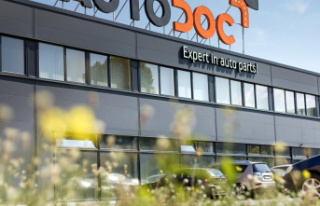Faster, more powerful, more comfortable – the competition is tough on the e-car market too. All luxury has tended to lead to ever greater power consumption. A trend that is now being fought.
At the beginning of the year, Mercedes showed with its EQXX Vision study that consumption of less than 10 kWh per 100 kilometers is possible. In a long-distance test drive, the concept vehicle required 8.7 kWh per 100 kilometers.
For comparison: a compact VW ID.3 consumes an average of at least 14.9 kWh/100 km according to the WLTP measurement method, and a BMW i3 15.3 kWh/100 km. With the air conditioning running in summer or the heating in winter, consumption quickly exceeds 20 kWh.
The highlight of the Mercedes EQXX: a particularly aerodynamic body. A vehicle uses 62 percent of the drive energy to clear air out of the way. 20 percent of the energy goes to the tires and only 18 percent goes to the weight.
“When it comes to power consumption, it is important to first improve aerodynamics, then weight and finally the tyres. Only then do the electric motor and battery follow,” explains Malte Sievers, development engineer at Mercedes.
The engineers fine-tuned the concept vehicle with a drag coefficient of just 0.17 (a measure of air resistance) in the wind tunnel until it was no longer possible to make any further improvements. However, some of the details cannot be implemented in a production vehicle for production reasons.
Similar to a car with a combustion engine, a smaller frontal area and a streamlined body ensure a low drag coefficient and thus lower fuel consumption.
"Teardrop-shaped bodies with the roof dropping off at the rear, like on the Tesla Model Y or the Mercedes EQXX, are very efficient," says Haydar Mecit, Professor of Urban Energy and Mobility Systems at the Institute for Electromobility at Bochum University.
Flowing shapes are therefore becoming a trend to reduce consumption. Aero efficiency also includes the design of the rims. "Visually closed wheels minimize turbulence and thus fuel consumption," he says. Manufacturers rely on special tire compounds to roll with as little resistance as possible for more range.
“The less the vehicle weighs, the less kinetic energy it has to use when moving off,” Mecit also points out. In addition to lighter steel or the use of aluminum, the greatest potential lies in the battery.
Modern vehicle batteries in electric vehicles weigh an average of 700 kilograms. "In the next five years, the energy density will continue to increase and the weight of the battery will probably drop by 20 to 30 percent," says Mecit.
Further savings potential: The use of silicon carbide in the chips, a compound of silicon (Si) and carbon (C), reduces losses at high operating voltages. In previous electric vehicles, 90 percent of the energy went to the wheel, with the Mercedes EQXX it is around 95 percent.
Five percent more efficiency means a longer range or a smaller, lighter battery. In the future, the lithium-ion battery will have liquid electrolytes and thus provide 20 percent more energy, as in the EQXX.
How much development is still in there? Professor Mecit believes that consumption of less than 10 kWh per 100 kilometers is possible for production vehicles in this decade. “There is still a lot of potential for development in electric drives, while petrol and diesel drives have long since reached their zenith,” he says. He still believes that the electric drive can achieve more than 30 percent efficiency gains.
This includes optimizing the electronics of the drive train. Car manufacturers currently use two types of electric motors: synchronous and asynchronous motors.
The permanently excited synchronous motor achieves the highest level of efficiency. So far, this has cost the most due to the use of rare earths, an asynchronous motor is cheaper but works less efficiently.
“In the future, both the electrical strip steels used and the windings in the motor will be further optimized. This will ensure more performance and less power consumption,” says Mecit.
Advantage Tesla: The US manufacturer has a technical lead of around five years with the battery and at least seven years with the electric motor compared to other manufacturers.
Jens Obernolte heads up energy and weight management at Volkswagen and is responsible for power consumption in the VW ID series. In order to further reduce consumption, he and his team are making many adjustments. With the successor to the current ID.3, Volkswagen is aiming for a weight saving of around five percent and a reduction in consumption of up to 20 percent.
This should be made possible, among other things, by increasing the efficiency of the powertrain, aerodynamics, thermal management, braking system and energy recovery. "We achieve the savings through many small changes in the overall vehicle and not just by increasing the efficiency of a component," says Jens Obernolte.
The thermal management is not included in the WLTP consumption, but drivers notice it in everyday life when they use air conditioning or heating. With the battery, Volkswagen is planning greater energy density for the next generation.
The VW expert also considers electricity consumption of less than 10 kWh per 100 kilometers to be realistic in the next ten years, but only for sedans. They offer a smaller frontal area than SUVs and can be optimized aerodynamically efficiently.
However, low consumption can also be achieved with a reduced speed. Above 60 km/h, air resistance plays a significant role in consumption, and above around 70 km/h, every additional 10 km/h costs around 10 percent more fuel consumption.
“With an electric car, speed is everything. Drivers can reduce fuel consumption on long journeys by driving more slowly, at around 120 km/h instead of 130 km/h,” he says. If they can avoid reloading in this way, they will also reach their destination faster in the end.
Assistance systems such as the sailing function also help to save energy. "When driving efficiently, drivers don't brake, they just coast or recuperate," he says.
Since the rolling resistance coefficient has a major impact on fuel consumption, e-car drivers should drive on optimized summer tires for as long as possible. With the correct tire pressure, it sails and drives optimally.
"Everything on shares" is the daily stock exchange shot from the WELT business editorial team. Every morning from 7 a.m. with the financial journalists from WELT. For stock market experts and beginners. Subscribe to the podcast on Spotify, Apple Podcast, Amazon Music and Deezer. Or directly via RSS feed.












